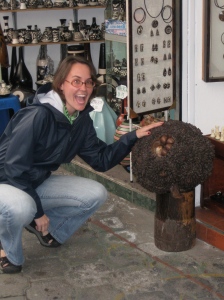DAT loves our relationship with the La Selva Jungle Lodge where we’ve worked for two years, but we feel our project would be a more rewarding experience for everyone if we could spend more time with communities in the jungle.
Our travel agent and friend, Lorena from Tierra Del Fuego, has been working with us for two summers now and has heard all about what we do. When I told her were were looking for a second jungle lodge, she suggested we meet with Edwin, the owner or the new Siona Lodge.
Located in the Cuyabeno Reserve in North Eastern Ecuador, this new lodge works with the Siona Indians. This native tribe is located in the middle of a nature reserve, so they don’t have the oil money/destruction coming in, which is a blessing as well as a disadvantage for the community. One of their blessings is that they have been able to hold on to a lot of their native customs.
Edwin has invited Jesse and I to visit at the end of December and speak with the current President of the tribe about our program and if he would like our group to visit, we will add this lodge as a second lodge during the jungle experience for ACTion: Ecuador. We also plan to spend a day engaging with the local artists to see if there are traditional dances, etc. that our artists can learn and take part in.
When speaking to Edwin about the traditional dance and dress he told us the elders of the community still hold onto the traditions, but the younger people yearn to be a little more modern. I was reminded of the experience learning mask dance in Quilotoa. Company Member Mady Spiegel explained it really eloquently in her piece for ACTion: Ecuador last year.
Our second night in Quilotoa we all piled into a one-room building; a classroom, where we pushed apart the desks, took off our shoes and socks and stepped on to the freezing stone floor. We laid down our masks and started exploring these strange creatures. The masks inched their way up our bodies slowly taking over, and then settled decisively on our faces. Each person embodied the character of their mask; many of us emerged as animals battling in the wild.
At one point during the workshop I looked up and saw a group of children from the community peering through the windows at us. They stayed there, out in the cold, dark Andean air for the entire 2 hour workshop. They shared our journey with us, laughed when we laughed, and clapped when we clapped.
After the workshop was over, the most flattering and interesting thing happened: all of a sudden the kids started scattering into the space where we had been. They rolled around on the floor imitating us. They looked at the masks with curiosity, wondering if they were allowed to pick them up and explore them as we had.
It made me think: aren’t these the masks that these same children sell at the market? This is the art of their ancestors, but do they get to learn about it as we did?
We were all moved by this experience of the children imitating us and in our discussions of this event an interesting point arose: How much creativity are these children exposed to? How often do they get to see adults play?
Are they so curious and eager to imitate because even though it’s part of their culture, it’s something they are unfamiliar with? Or is it interesting to them because we are silly gringos playing in their classroom? Maybe through our interest in their culture, we’ve encouraged an interest for them in their culture that has been lost.
It’s possible that we have reintroduced them to their own culture through their imitation of us. Copywrite: Mady Spiegel, 2009
I also remember experiencing this during the group I was there for. I brought this up with Edwin. Maybe it would be a good opportunity for us to encourage the young people simply by bring in people who are interested in learning and sharing this art. And who better to be excited about something than groups of Theatre Artists!? Am I right?
More news from the lodge after our visit, for now check their websites, La Selva and Siona



